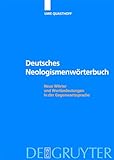Deutsches Neologismenwörterbuch : Neue Wörter und Wortbedeutungen in der Gegenwartssprache / hrsg. von Uwe Quasthoff.
Material type: TextPublisher: Berlin ; Boston : De Gruyter, [2011]Copyright date: ©2007Description: 1 online resource (690 p.)Content type:
TextPublisher: Berlin ; Boston : De Gruyter, [2011]Copyright date: ©2007Description: 1 online resource (690 p.)Content type: - 9783110188684
- 9783110911138
- online - DeGruyter
- Issued also in print.
| Item type | Current library | Call number | URL | Status | Notes | Barcode | |
|---|---|---|---|---|---|---|---|
 eBook
eBook
|
Biblioteca "Angelicum" Pont. Univ. S.Tommaso d'Aquino Nuvola online | online - DeGruyter (Browse shelf(Opens below)) | Online access | Not for loan (Accesso limitato) | Accesso per gli utenti autorizzati / Access for authorized users | (dgr)9783110911138 |
I-IV -- Vorwort -- Benutzungshinweise -- Methodologische Hinweise -- Aa -- Bb -- Cc -- Dd -- Ee -- Ff -- Gg -- Hh -- Ii -- Jj -- Kk -- Ll -- Mm -- Nn -- Oo -- Pp -- Qq -- Rr -- Ss -- Tt -- Uu -- Vv -- Ww -- Xx -- Zz
restricted access online access with authorization star
http://purl.org/coar/access_right/c_16ec
Das Neologismenwörterbuch dokumentiert die Wortneubildungen in der Gegenwartssprache ab dem Jahr 2000 wissenschaftlich fundiert und mit realen Belegen. Zwar gibt es zahlreiche ‚Trendwörterbücher‘, sie sind aber allesamt eher populärwissenschaftlich geschrieben und methodisch unzureichend. Das Leipziger Neologismenwörterbuch basiert hingegen auf den Daten des Projekts „Deutscher Wortschatz“ der Universität Leipzig mit mehreren Millionen von Sätzen pro Jahr. Verzeichnet werden mehr als 2.200 Wörter, die entweder neu gebildet wurden, aus anderen Sprachen neu ins Deutsche eingedrungen sind oder – bei unveränderter Gestalt – mit neuer Bedeutung verwendet werden und deren Verwendungshäufigkeit auf die Aufnahme in die Alltagssprache schließen lässt. Das Wörterbuch bietet zu jedem Stichwort Bedeutungserklärungen sowie zahlreiche authentische Belege; erstmals ist darüber hinaus in jeden Artikel ein Häufigkeitsdiagramm eingebunden, das die ‚Gebrauchsgeschichte‘ eines jeden Neologismus dokumentiert. Zielgruppe des innovativen Werkes sind neben Sprachwissenschaftlern insbesondere auch Journalisten und allgemein an sprachlichen Entwicklungen Interessierte.
The dictionary lists all new coinages, loan words borrowed from other languages, and words that have taken on new meaning (while retaining their original form) in the German language since 2000. The list of lemmata was established with the help of automatic frequency analysis, in which the statistical frequency of the occurrence of a word was a factor that determined whether that word would appear as an entry in the dictionary. Special lexicographic features of the dictionary entries include not only the definition of the neologism, the date of its first usage and the citation of numerous authentic documentations of its usage, but also diagrams illustrating the history of the usage of each neologism. The dictionary is comprised of data taken from the analysis of a language corpus from Leipzig University containing millions of entries. Extensive lexicographical description of all neologisms that have been introduced into the German language since 2000 Based on the Leipziger language corpus of modern German containing millions of entries Provides information such as the orthography, definition and citation of the first documented use of each neologism Includes diagrams illustrating the frequency and history of use of each individual neologism
Issued also in print.
Mode of access: Internet via World Wide Web.
In German.
Description based on online resource; title from PDF title page (publisher's Web site, viewed 29. Jun 2022)


